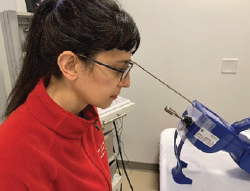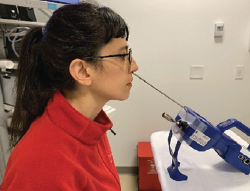Is office laryngoscopy an aerosol-generating procedure (AGP), and how can aerosolizing potentials in invasive otolaryngological interventions be critically assessed?
BOTTOM LINE: Assessment using an optical particle sizer indicates that office laryngoscopy is likely not an AGP, but studies using more sophisticated methods of droplet distribution measurement could yield more conclusive results.
Explore This Issue
November 2020BACKGROUND: The COVID-19 pandemic has sparked concern and speculation about possible viral transmission during potential AGPs. Regarding office laryngoscopy, there is insufficient evidence to conclude that the procedure can generate aerosols. Ultimately, a better understanding of the aerosol-generating risk of otolaryngological procedures is critical to guarding against infection.
STUDY DESIGN: Prospective study using clinical simulation.

Experimental setup for flexible laryngoscopy.

Rigid laryngoscopy and speech. © Source Rameau et al.
SETTING: The Sean Parker Institute for the Voice, Department of Otolaryngology–Head and Neck Surgery, Weill Cornell Medical College, New York.
SYNOPSIS: Researchers recruited two healthy adult volunteers (one female, one male) to undergo flexible and rigid laryngoscopies. An optical particle sizer (OPS) was used to quantify aerosols and droplets generated for four positive controls relative to ambient particles—speech, breathing, /e/ phonation, and /æ/ phonation—and for five test interventions relative to breathing and phonation: flexible laryngoscopy, flexible laryngoscopy with humming, flexible laryngoscopy with /e/ phonation, rigid laryngoscopy, and rigid laryngoscopy with /æ/ phonation. Results showed statistically significant increases in particle counts for breathing relative to background, and no significant increases for flexible laryngoscopy, flexible laryngoscopy with humming, flexible laryngoscopy with /e/ sound, rigid laryngoscopy, and rigid laryngoscopy with /æ/ sound relative to breathing or phonation for any particle size. However, authors noted that OPS is susceptible to errors related to sizing and related miscounts, and optical properties of the particles measured. Study limitations included a limited number of replicates due to study restrictions in a COVID-19 pandemic setting.
CITATION: Rameau A, Lee M, Enver N, et al. Is office laryngoscopy an aerosol-generating procedure? Laryngoscope. 2020;130:2637-2642.